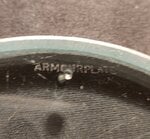Hi All, first post,
I recently came across this local ad and I was wondering if anyone you identify this glass? My gut instinct is telling me its probably just regular glass.
This item is described as:
WW2 armoured plate glass aeroplane window x12
When I messaged the seller, he just said thats what the person he got it from said...
Thanks
JJZ



I recently came across this local ad and I was wondering if anyone you identify this glass? My gut instinct is telling me its probably just regular glass.
This item is described as:
WW2 armoured plate glass aeroplane window x12
When I messaged the seller, he just said thats what the person he got it from said...
Thanks
JJZ


